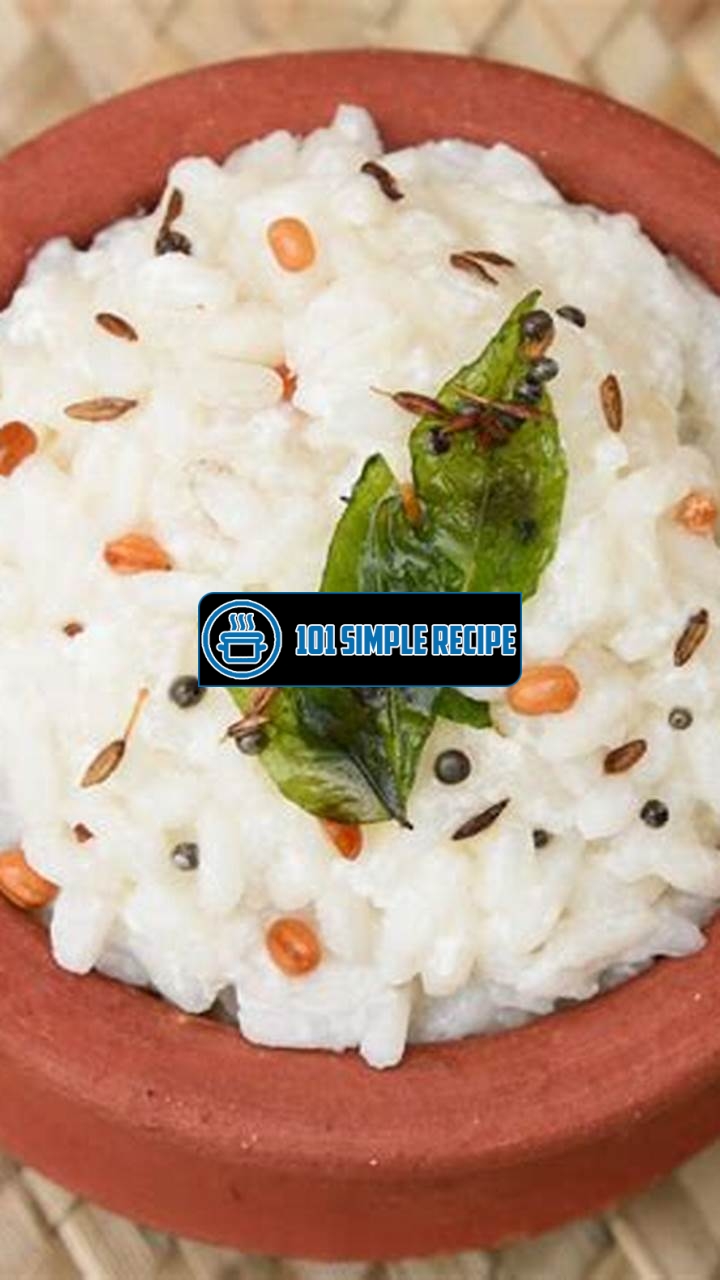Welcome to a delicious journey, where you will discover the art of perfecting the curd rice recipe. In this culinary adventure, you will uncover the secrets behind creating a dish that is not only satisfying but also bursts with flavors. Whether you are a seasoned chef or a novice in the kitchen, this article will guide you through the process of preparing curd rice with ease and finesse. So, get ready to tantalize your taste buds as we embark on this flavorful exploration.

What is Curd Rice?
Indulge in a delightful culinary experience as you discover the wonders of curd rice, a traditional Indian dish that has captivated taste buds across the world. Made from a unique blend of yogurt and rice, this creamy creation offers a sensational combination of flavors and textures that will leave you craving for more.
Origins of Curd Rice:
Let’s take a fascinating journey back in time to unravel the origins of this beloved dish. Curd rice, also known as “thayir sadam” in Tamil, has its roots deeply embedded in the cultural fabric of South India. It has been a staple in Tamil Nadu households for centuries, believed to have been introduced by the ancient Chola dynasty. These custodians of a vast empire relished the simplicity and nourishment offered by curd rice during their conquests.
Ingredients for Curd Rice:
To perfect the curd rice recipe, you’ll need a few key ingredients. Let’s explore these components that make this dish so extraordinary:
- Rice: Using short-grain rice varieties like Sona Masuri or Ponni rice provides the ideal texture for curd rice.
- Yogurt: Opt for fresh and creamy yogurt to get that luscious consistency and tangy flavor.
- Milk: Adding a touch of milk helps to achieve the desired creaminess.
- Seasonings: Enhance the taste with mustard seeds, curry leaves, ginger, green chilies, and chopped coriander.
- Vegetables: Finely chopped cucumber, carrots, and pomegranate seeds add a delightful crunch and burst of color.
- Tempering: A quintessential step in the process involves tempering with ghee, mustard seeds, urad dal, and asafoetida.
Health Benefits of Curd Rice:
Besides its delectable taste, curd rice also provides numerous health benefits. This humble dish works wonders for your digestive system, thanks to the probiotics present in yogurt. Probiotics promote healthy gut bacteria, aiding in digestion and boosting your immunity. The cooling properties of curd help to soothe your stomach and provide relief from acidity.
Curd rice is also a great source of calcium, protein, and essential vitamins. It aids in strengthening bones, muscles, and teeth. Additionally, the combination of rice and yogurt offers a balanced array of carbohydrates, fats, and proteins, making it a wholesome and satisfying meal option.
Embark on this scrumptious journey with curd rice and relish every spoonful of this delightful creation. The blend of creamy yogurt, fluffy rice, and vibrant flavors is sure to transport your taste buds to culinary bliss!
To Summarize:
Curd rice is a beloved traditional Indian dish made from yogurt and rice. Its origins can be traced back to the ancient Chola dynasty in South India. The recipe includes ingredients such as rice, yogurt, milk, seasonings, and vegetables. Apart from its delicious taste, curd rice offers health benefits including improved digestion, boosted immunity, and a rich source of essential nutrients. Try this delightful dish today and savor the incredible flavors!
The Perfect Curd Rice Recipe
Discover the step-by-step instructions to make delicious and creamy curd rice.
Cooking the Rice
To start perfecting the curd rice recipe, you must first cook the rice. The type of rice you choose is important, as it will impact the final texture and taste of the dish. For the best results, use short-grain rice or traditional Indian rice like Sona Masoori or Basmati rice. Begin by rinsing the rice thoroughly to remove any excess starch.
Next, bring a pot of water to a boil and add the rinsed rice. Cook the rice until it is tender and fluffy. This should take about 15-20 minutes, depending on the type of rice you are using. Make sure not to overcook the rice, as it will turn mushy and affect the overall texture of the curd rice.
Preparation of Curd Mixture
While the rice is cooking, prepare the curd mixture that will add that tangy and creamy flavor to your curd rice. In a bowl, whisk together fresh curd or yogurt with a pinch of salt. You can also add a little milk to achieve the desired consistency. The curd should be smooth and creamy, without any lumps.
Optional ingredients such as grated ginger, finely chopped green chilies, and freshly chopped coriander leaves can be added to enhance the flavor. These ingredients will add a refreshing and spicy kick to the curd rice. Mix everything well until it is evenly combined.
Tempering and Mixing
Now comes the flavorful step of tempering the curd rice. In a small pan, heat some oil or ghee over medium heat. Add mustard seeds and let them splutter. Then, add finely chopped curry leaves, asafoetida, and urad dal. Fry until the urad dal turns golden brown and the curry leaves become crispy.
Pour this tempering over the cooked rice and mix well. Ensure that each grain of rice gets coated with the tempered spices. The aromatic flavors of the tempering will infuse into the rice, adding a burst of taste.
After mixing the rice and tempering, add the prepared curd mixture. Fold the curd mixture gently into the rice to avoid breaking the grains. Make sure the curd is evenly distributed throughout the rice.
Finally, check the seasoning and adjust as per your taste. You can add salt or freshly ground black pepper if desired. Once everything is combined, cover the curd rice and let it sit for about 10-15 minutes. This resting period will allow the flavors to meld together.
Now that your delicious curd rice is ready, you can serve it as is or pair it with some tasty accompaniments like pickle or papad. The creamy, tangy, and flavorful curd rice is a perfect dish for any meal of the day. Enjoy!
Adding Flavors and Variations
When it comes to curd rice, there are numerous ways to elevate its taste and experiment with exciting variations. By incorporating different flavors and ingredients, you can create a unique and delicious dish that will leave your taste buds wanting more.
Tempering with Spices
One way to add flavor to your curd rice is by tempering it with spices. This technique involves frying spices in oil or ghee and then adding them to the rice. The heat from the oil releases the flavors of the spices, infusing the dish with a delightful aroma and taste. Some commonly used spices for tempering curd rice include mustard seeds, cumin seeds, dried red chilies, and curry leaves. The combination of these spices adds a subtle hint of spice and warmth to the dish. ️
Adding Vegetables and Fruits
To make your curd rice more nutritious and visually appealing, consider adding a variety of vegetables and fruits to it. Vegetables like shredded carrots, finely chopped cucumbers, and grated cabbage not only provide a refreshing crunch but also add a burst of color to the dish. You can also incorporate fruits such as pomegranate seeds or diced mangoes for a touch of sweetness and tanginess. These additions not only enhance the taste but also make the dish more vibrant and wholesome.
Besides vegetables and fruits, you can also experiment with adding cooked lentils or sprouts to your curd rice. This will not only increase the protein content of the dish but also provide a unique texture and flavor. Additionally, adding roasted nuts like cashews or almonds can lend a delightful crunch and rich taste to your curd rice.
Experimenting with Toppings and Garnishes
Another way to take your curd rice to the next level is by experimenting with an array of toppings and garnishes. Popular choices include fresh coriander leaves, grated coconut, and a sprinkle of roasted cumin powder. These toppings not only add an aromatic touch to the dish but also provide an interesting contrast in flavors. For a tangy twist, you can add a dollop of tangy pickle or a squeeze of lime juice as a garnish. The possibilities are endless, allowing you to tailor the toppings to your taste preferences.
For those who enjoy a spicy kick, consider adding a generous amount of freshly ground black pepper or green chilies as a finishing touch. This will add a fiery element to the dish, making it perfect for those who crave bold flavors. ️
With all these exciting ways to enhance the taste of curd rice, the possibilities are truly endless. Don’t be afraid to get creative and experiment with different flavors, ingredients, and combinations. Remember, the key is to strike a balance between flavors and textures, creating a dish that is not only delicious but also visually appealing. So go ahead, embark on this delicious journey of perfecting the curd rice recipe, and enjoy the amazing culinary experience that awaits you!
Curd Rice as a Complete Meal
Discover the nutritional value and versatility of curd rice as a standalone dish.
Curd rice, also known as yogurt rice, is a wholesome and delicious meal that is popular in South India. It is made by mixing cooked rice with curd (yogurt) and seasoned with various spices. This simple yet flavorful dish is not only satisfying but also packed with numerous health benefits.
Nutritional Value: Curd rice is a complete meal that provides a balanced combination of carbohydrates, proteins, and fats. The rice provides the necessary energy, while the curd adds protein and essential probiotics. It is also rich in vitamins like vitamin B12 and vitamin D, as well as minerals like calcium and phosphorus. These nutrients contribute to the overall well-being of the body.
Versatility: Curd rice can be easily customized according to personal preferences and dietary needs. You can add various ingredients such as grated carrots, chopped cucumbers, pomegranate seeds, or even nuts to enhance the taste and texture. It can be enjoyed as a main course or as a side dish with other Indian delicacies.
Importance of Probiotics
Probiotics: One of the key components of curd rice is curd, which is a natural source of probiotics. Probiotics are live bacteria and yeasts that are beneficial for the digestive system. They help in maintaining a healthy balance of good bacteria in the gut, improving digestion, and strengthening the immune system. Including curd rice in your diet can promote a healthy gut and overall well-being.
Balancing the Meal
While curd rice is a nutritious dish on its own, it is essential to balance it with other food groups for a well-rounded meal. Adding a variety of vegetables, such as spinach or bell peppers, provides additional vitamins and minerals. Including a source of protein, like lentils or grilled chicken, helps in meeting the daily protein requirements. To enhance the flavors, you can season the curd rice with a pinch of roasted cumin powder, black pepper, and salt.
Hydration: It is important to stay hydrated while consuming curd rice as it can be quite filling. Drink plenty of water or opt for fresh fruit juices to complement the meal and aid in digestion.
Serving Suggestions
Meal Ideas: Curd rice can be enjoyed as a complete meal by itself. However, you can also pair it with South Indian accompaniments like papad, pickle, and sambar for a more traditional experience. It is also a great option for lunchboxes or a quick and easy dinner.
Variations: Experiment with different flavors and textures by adding ingredients like grated ginger, chopped green chilies, or curry leaves. You can also substitute regular rice with brown rice or millets for a healthier twist.
Temperature: Curd rice is best served chilled, especially during hot summer days. You can refrigerate it for a few hours before serving or add ice cubes to enhance the cool and refreshing experience.
Overall, curd rice is a versatile and nutritious dish that can be enjoyed by people of all ages. The combination of curd and rice along with various spices and additions makes it a delightful culinary experience. Incorporate curd rice into your meal plan and savor its unique flavors and health benefits.
Curd Rice: Tradition and Culture
Explore the cultural significance and traditional practices associated with curd rice.
Curd Rice in Festivals and Celebrations
In various festivals and celebrations across India, curd rice has become an integral part of the traditional cuisine. This creamy and tangy rice dish holds immense importance and is prepared with great care to honor the cultural heritage of the country.
During festivals like Pongal in Tamil Nadu or Ugadi in Andhra Pradesh, curd rice is prepared as an essential offering to deities. It is believed to bring prosperity and good fortune to devotees. The dish is also prepared during religious ceremonies and distributed among devotees as prasadam (holy food).
Furthermore, curd rice plays a significant role during important occasions such as weddings and birthdays. It is often served to guests as a part of the traditional meal, symbolizing hospitality and warmth. This simple yet delicious dish brings people together and is shared as a way to celebrate these joyous occasions.
The Symbolism and Rituals
Symbolically, curd rice represents the harmony of flavors and textures. The combination of yogurt, rice, and various spices creates a perfect balance that reflects the harmonious nature of life itself. The cooling properties of yogurt in curd rice also symbolize calmness and serenity.
In some households, curd rice is prepared with specific rituals and customs. For example, the rice is cooked with special ingredients like fenugreek seeds, which are believed to have medicinal properties. This highlights the belief that consuming curd rice is not just a culinary practice but also a way to promote overall well-being.
Additionally, the act of preparing and serving curd rice holds cultural significance. It is often made with love and affection for family members, and serving it signifies caring and nurturing relationships. The process of cooking curd rice is seen as a way to connect with one’s roots and preserve traditional values.
Regional Variations
While curd rice is a popular dish across India, different regions have their own unique variations. For example, in South India, curd rice is often tempered with mustard seeds, curry leaves, and red chili to add a spicy kick. In North India, a sweeter version called “mishti doi” is made by adding jaggery or sugar to the curd rice.
Regional variations also extend to the choice of rice used. Some regions prefer using short-grain rice, while others opt for basmati rice to enhance the texture and aroma. The choice of spices and condiments like grated ginger or chopped coriander leaves also varies based on regional preferences.
Note: Curd rice is a versatile dish that can be adapted to suit individual tastes and regional flavors.
In conclusion, curd rice holds immense cultural significance and is deeply rooted in Indian traditions. It reflects the importance of communal celebration, symbolism, and the preservation of regional flavors. Whether enjoyed during festivals or as a comforting meal at home, curd rice continues to be a delicious journey that encapsulates the essence of Indian cuisine and culture.
Thank you for taking the time to read this article on the delicious and easy-to-make curd rice recipe. We hope you found the information helpful and inspiring. Whether you are a seasoned chef or a beginner in the kitchen, curd rice is a versatile dish that will satisfy your taste buds. So, the next time you’re looking for a quick and healthy meal option, don’t forget to try making curd rice. We’ll see you again soon with more exciting recipes and cooking tips!
Frequently Asked Questions
Here are some frequently asked questions about curd rice:
| No. | Questions | Answers |
|---|---|---|
| 1. | What are the ingredients required to make curd rice? | The main ingredients for curd rice are cooked rice, curd (yogurt), salt, and tempering ingredients like mustard seeds, urad dal, curry leaves, and green chilies. |
| 2. | Can I add vegetables to curd rice? | Yes, you can add vegetables like grated carrots, finely chopped cucumbers, or pomegranate seeds to enhance the taste and nutritional value of curd rice. |
| 3. | How long does it take to prepare curd rice? | The preparation time for curd rice is approximately 10 minutes, excluding the time required for cooking the rice. |
| 4. | Can I use leftover rice to make curd rice? | Yes, curd rice is a popular dish to use leftover rice. It can be a delicious way to repurpose cooked rice from a previous meal. |
| 5. | Can I adjust the spiciness of curd rice? | Absolutely! You can adjust the spiciness of curd rice by adding more or fewer green chilies according to your taste preference. |
| 6. | Is curd rice a healthy dish? | Curd rice is not only delicious but also nutritious. It is rich in probiotics, calcium, and protein, making it a beneficial choice for your overall health. |
Closing Thoughts
We hope you enjoyed learning about the curd rice recipe and its versatility. It’s a fantastic dish that can be enjoyed as a complete meal or as a side dish. The creamy texture and subtle tanginess of curd rice make it a favorite among many. Remember to experiment with different toppings and flavors to create your unique version. Don’t hesitate to come back to our website for more exciting recipes and culinary inspiration. Happy cooking and bon appétit!
Jump to Recipe
Curd Rice Recipe

Learn how to make the delicious curd rice recipe with this step-by-step guide. It’s a creamy and tangy dish that can be enjoyed as a main course or side dish.
- Cooked rice – 2 cups
- Curd (Yogurt – 1 cup)
- Salt – 1/2 teaspoon
- Mustard seeds – 1/2 teaspoon
- Urad dal – 1/2 teaspoon
- Curry leaves – a few
- Green chilies – 2 (finely chopped)
- Ghee (Clarified Butter – 1 tablespoon)
- Asafoetida (Hing – a pinch)
- Take a bowl and add the cooked rice. Mash the rice lightly with the back of a spoon to make it slightly mushy.
- Add curd (yogurt) to the mashed rice and mix well. Ensure that the rice and curd are evenly combined.
- In a small pan, heat ghee. Add mustard seeds and let them splutter. Then, add urad dal, curry leaves, and green chilies. Fry until the dal turns golden brown.
- Pour the tempering over the curd rice mixture and mix well. Add salt and a pinch of asafoetida.
- Your delicious curd rice is ready to serve! You can garnish it with chopped coriander leaves or grated carrots for additional flavor and freshness.






